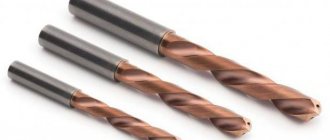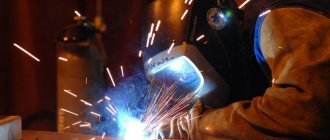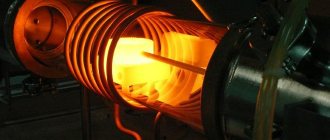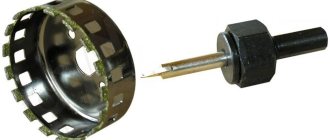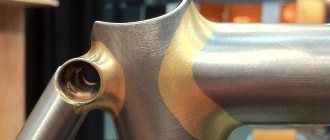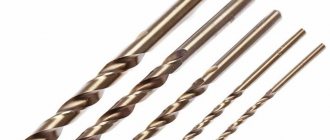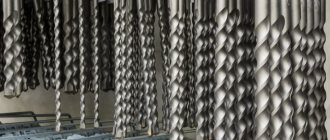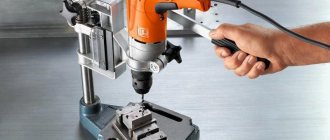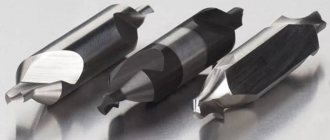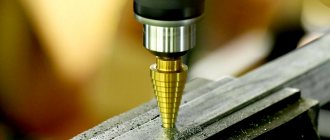Cobalt drill is the common name for a tool for drilling holes in cobalt-alloyed high-speed steel. Quick-cut drills are characterized by increased stability under intensive operating conditions, and cobalt additives significantly increase their heat resistance and allow them to work even with red-hot tools. Cobalt drills are most often used for drilling holes in particularly strong and tough steels and alloys. Structurally, they are completely identical to carbon steel drills and can have both cylindrical and conical shanks. Most manufacturers produce such tools in three versions: mirror polished, blued and with a wear-resistant coating, which is usually titanium compounds. Cobalt drills are several times more expensive than tool steel products. But at the same time, they have much greater productivity and wear resistance, which makes it possible to drill even stainless steel with a cutting speed of more than 20 m/s.
Marking and color of cobalt drills
In accordance with GOST 2034-80, on the shanks of drills with a thickness of more than three millimeters, in addition to the diameter, the grade of metal from which this tool is made must be applied. Two types of marking are allowed: in the form of a GOST alphanumeric code and an international abbreviation indicating the type and percentage of the ligature. GOST 20698-75 defines three types of steel for making drills with cobalt: P6M5K5, P9K5 and P9M4K8. Here, the first letter means “high-speed steel,” the second is the average tungsten content in percent, the letters M and K are molybdenum and cobalt additives, respectively, and the numbers following them are their average percentage content. For example, in one of the most common cobalt steels, P6M5K5, the cobalt content is 4.70÷5.20%, and in P9M4K8 - 7.50÷8.50%. In accordance with the international designation, the shank of a drill made from them will be engraved with HSS Co 5 or HSS Co 8 (the first three letters are the English abbreviation for “high-speed steel”).
As a result of additional processing of the spiral surfaces of cobalt drills, their corrosion and wear resistance increases, and the sliding of chips along the grooves improves. The most common are three types of such processing: steam oxidation (blueing), mirror polishing and application of wear-resistant coatings. In the first case, the instrument becomes black, and in the second it becomes shiny silver.
Titanium nitride, which has a golden color, as well as titanium-aluminum nitride, which gives the tool a grayish-bluish color, are most often used as wear-resistant coatings.
Features and Specifications
The cobalt additive to the tungsten-molybdenum quick cutter increases its heat resistance (more precisely, red resistance) to 600÷650 ºC, so cobalt metal drills can operate at higher speeds in viscous materials. At the same time, alloying with cobalt increases the price of the tool, so its use at home is only advisable for large volumes of drilling such complex materials as stainless steel and titanium alloys.
It is also necessary to remember that quick-cutters with a cobalt additive are quite fragile, so such drills cannot be dropped onto concrete or operated under variable axial loads.
Drilling with a cobalt drill for metal
Even before you start drilling, you should decide the issue with the cutting mode. To clarify, let us inform you that the main parameters that affect such a mode are the following:
- Cutting speed . It is usually understood as the conditional peripheral speed of a drill for metal, which is demonstrated by the drill in relation to the element being processed. In other words, this parameter means the degree of rotation speed of the drill through metal. For example, it is possible to ensure the same cutting speed of 20 m/min, provided that a drill with a diameter of 1.0 is used for the work, and its rotation speed is 6366 times per minute, or you can use a device whose diameter is 10.0, and the frequency rotation is 637 rpm.
- Submission . We are talking about the degree of movement of the working device in the direction of the drilling axis over a period equal to one revolution. Accordingly, the unit of measurement is millimeter per revolution.
- Torque . This parameter determines the level of load that falls on the metal drill during cutting.
Each of the above parameters influence each other, and when choosing them it is necessary to take into account:
- The material in which the hole needs to be created;
- The material from which the metal drill is made is cobalt;
- Equipment used for work and type of cooling;
- Other factors, which include the degree of surface roughness, contamination, etc.
Advantages of a drill with cobalt
The main indicator of equipment productivity in machining is the cutting time spent on manufacturing a part, which consists of the duration of individual operations (drilling, milling, grinding, etc.). In turn, the main time of an individual operation is determined by the speed and depth of cut, which directly depend on the characteristics of the tool. Among them, the main ones are mechanical strength, wear resistance and heat resistance. In these parameters, cobalt drills are significantly superior to tools made of carbon tool steel. For example, the temperature at which the cutting part of a drill made from U12 steel is tempered does not exceed 160 ºC, while for the P9M4K8 cobalt alloy this figure is 630 ºC. In addition, the cutting speeds of the same materials for these two types of tools differ by 2–2.5 times.
Cost of tools
On average, the cost of cobalt drills used for work on stainless steel is 4–5 times higher than the price of conventional ones. The cost of a drill belonging to the cobalt category is influenced by a number of parameters:
- design (one- or two-sided);
- working diameter;
- length (total and working);
- the brand name under which the drill is manufactured.
Cobalt drilling tools manufactured by well-known and reputable European companies have the highest price on the domestic market. A budget option are drills of the domestic brand “Zubr”, also produced in the “Cobalt” category. Despite the low cost, domestic cobalt tools are of decent quality and allow you to create precise and neat holes in the material being processed.
Processed materials
Drilling tools made from quick-cutting tools with cobalt additives were originally created to work under conditions of increased heating of cutting edges, which occurs when processing hard and viscous materials. Therefore, it is most advisable to use it when drilling stainless steel and heat-resistant alloys, as well as cast iron products. Another area of application for such a tool is drilling aluminum and magnesium alloys with a high silicon content. In addition, cobalt drills are indispensable when working with materials that have low thermal conductivity, which include a number of thermoplastics and many modern composites.
Main characteristics
The most significant characteristics of cobalt drills for stainless steel and other difficult-to-process materials include the following.
- Even when drilling perfectly smooth surfaces, cobalt tools do not move to the side at the initial stage of processing, so at the location of the center of the hole being created, there is no need to make a recess using a core or countersink.
- Holes created using cobalt drills are distinguished not only by exceptional accuracy of geometric parameters, but also by high quality workmanship: there are no burrs or other defects on the inner surface of such holes. In addition, using this tool for drilling stainless steel allows you to avoid such a serious problem as biting the material in the processing area.
- Drills made of high-speed steel alloyed with cobalt are characterized by increased wear resistance.
- If we compare such drills with others, the speed of processing when using them is almost twice as high.
- Due to the mechanical characteristics of the manufacturing material and the design features of such drills, they are successfully used for precise drilling of pipes and welds.
- When drilling stainless steel or any other material using cobalt drills, the master uses less physical effort than when using other types of tools.
Cobalt drills are produced by most manufacturers of equipment and consumables
Recommendations for use
Drilling tools made from steels with cobalt additives are quite fragile, so during operation they should not be subject to shock. When placing it in storage areas (tool cabinets, cases or bedside tables), it should not be piled in bulk with the rest of the tools and equipment, as this can lead to damage to the working edges and protective coating. The latter gradually wears out during operation, which leads to increased friction of the working part and a decrease in the chip removal speed. Therefore, it is recommended to periodically resharpen the cutting part and then apply a new protective coating. Cobalt drills are more expensive not only than similar products made from tool steel, but also more expensive than drilling tools made from a conventional quick cutter. In this regard, they should be used only for their intended purpose, and not used in cases where a cheaper tool can be used.
Types by design
According to their design, drills belonging to the cobalt category are divided into two main types: single- and double-sided.
The first ones, in full accordance with their name, have a cutting part made on only one side. Double-sided drills are essentially two tools in one body. Their design feature is that there is a separate cutting part at both ends. The convenience of using such a tool is that if one of its cutting parts breaks, you can immediately use the second one, simply by reinstalling the drill in the chuck of the equipment used.
Double-sided cobalt drills are intended for installation work on thin-walled materials
Tips for choosing a cobalt drill bit
Cobalt quick-cut drills are a rather expensive tool, since by definition they cannot be very cheap.
Therefore, one of the ways to select a quality product may be to compare its price with products from brands that have a good reputation: Bosh, Sandvik, Dormer, Mitsubishi, Ruko, etc. Unfortunately, the more expensive the product, the greater the desire of unscrupulous manufacturers to counterfeit it (well known low-quality Chinese drills with Russian markings). Therefore, in any case, you should purchase these products from well-established sellers, having carefully studied customer reviews before doing so. Also, specialized forums can be a good help, where you can not only read the opinions of experts, but also ask your question. Among Russian brands with an established reputation, it is worth noting the products of the TIZ plant, as well as cobalt drills “Zubr” and “Praktika”. Listed above are several Russian manufacturers and sellers of cobalt drills, which we believe deserve special attention. If we missed anyone, please share information about this brand in the comments.
